50 ideas y consejos de expertos en diseño y distribución de almacenes
Diseñar un diseño de almacén parece una tarea simple, pero en realidad es bastante complejo. De hecho, el diseño y la disposición de su almacén pueden hacer o deshacer la productividad de su operación, afectando el tiempo de selección, las horas de trabajo e incluso aumentando los riesgos de seguridad debido a un flujo de tráfico deficiente.
Hemos reunido a 50 expertos en diseño y disposición de almacenes ideas, consejos y estrategias para ayudarlo a diseñar el diseño ideal para sus instalaciones para optimizar la productividad del almacén y mejorar la seguridad. Haga clic en uno de los enlaces a continuación para acceder a los consejos de una sección específica:
- Sugerencias para la planificación del diseño del almacén
- Consideraciones al diseñar un diseño de almacén
- Ideas de diseño de diseño de almacén
Sugerencias para la planificación del diseño del almacén
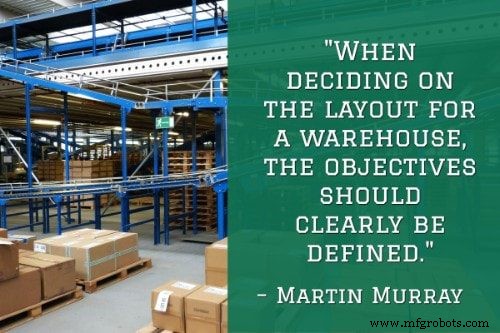
1. Defina sus objetivos antes de comenzar el proceso de planificación. “Al decidir sobre el diseño de un almacén, los objetivos deben estar claramente definidos. Los objetivos deben estar alineados con la estrategia general de almacenamiento de la empresa. Los objetivos se pueden definir a un alto nivel, como reducir los costos de almacenamiento o brindar el máximo servicio al cliente.
“Igualmente, los objetivos pueden ser más específicos, como maximizar el espacio de almacenamiento, proporcionar la máxima flexibilidad en el almacén o aumentar eficiencia de almacenamiento sin aumentar los recursos”. – Martin Murray, Planificación y optimización del diseño de su almacén:impacto en la cadena de suministro , La Pequeña Empresa Equilibrio; Twitter:@thebalance
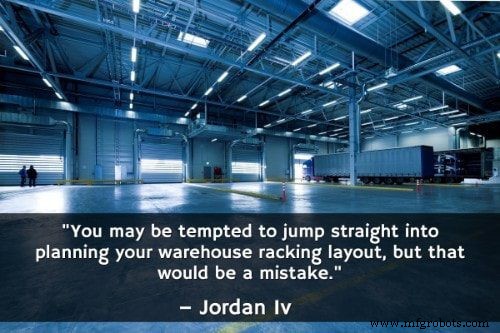
3. Busque la opinión de sus gerentes y contratistas. “Es posible que sienta la tentación de saltar directamente a la planificación de la disposición de las estanterías de su almacén, pero eso sería un error. Antes de comenzar, hable con contratistas expertos (como su empresa de manejo de materiales), su(s) gerente(s) de almacén e incluso sus conductores:tienen años de experiencia en operaciones y planificación de instalaciones de almacén, sin mencionar la experiencia en su almacén específico. Explique sus objetivos y requisitos, y luego escuche sus sugerencias”. – Jordan Iv, Cómo diseñar un diseño de estanterías de almacén:10 pasos para una planificación eficiente , LinkedIn
“Recomendamos implementar métodos automatizados de recopilación de datos de seguimiento de activos para evitar errores posteriores:la entrada manual es un no no. Vaya un paso más allá y asigne números de seguimiento únicos a los activos, no confíe en los números de serie (que a menudo no son únicos). Y no solo realice un seguimiento de los bienes muebles, realice un seguimiento de sus activos fijos también”. – Cody Adams, 13 consejos para el diseño y distribución de su almacén definitivo , Formaespacio; Twitter:@RealFormaspace
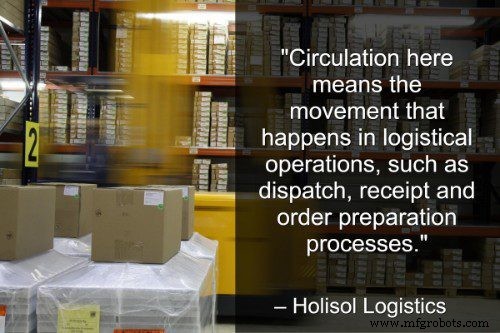
5. Comprenda cómo circulan las mercancías a través de sus instalaciones. “Circulación aquí significa el movimiento que ocurre en las operaciones logísticas, como los procesos de despacho, recepción y preparación de pedidos. La rotación de productos es la frecuencia con la que se renuevan los bienes, es decir, un producto de alta rotación es aquel que tiene una alta tasa de entrada y salida. El movimiento de cargas implica costos, por lo que es mejor minimizar el movimiento, siempre que el procedimiento operativo de la empresa lo admita. Detectar estos flujos es muy importante ya que contribuyen a definir lo que se necesita para un diseño de almacén efectivo”. – 5 factores para un diseño de almacén perfecto , Holisol Logística; Twitter:@HolisolLogistic
“La forma más lógica de iniciar esta fase es determinar las relaciones espaciales entre las áreas del almacén. Hay muchos aspectos que deben tenerse en cuenta al dibujar relaciones entre áreas. Sobrestimar o subestimar la importancia y el impacto de cualquier factor puede resultar perjudicial para el flujo del almacén. Nuestro equipo de consultoría utiliza un sistema de calificación lógica para resolver este problema.
“El próximo paso de esta fase es determinar la cantidad de espacio que requiere cada área. Hay varias formas de realizar esta tarea. Ciertos métodos pueden funcionar mejor que otros en una situación dada. Por ejemplo, en algunos casos, es posible que las instalaciones no tengan información histórica sobre las áreas que se diseñarán, mientras que otras pueden haber establecido estándares de espacio.
“Después de establecer los requisitos de espacio, se pueden hacer ajustes para tener en cuenta las limitaciones y necesidades específicas de cada zona. Por ejemplo, algunas áreas pueden requerir una puerta de salida y podría tener sentido dar más espacio de pasillo a otras áreas”. – Marvin Logan, Cómo crear un mejor diseño de almacén , Bastián Soluciones; Twitter:@BastianSolution
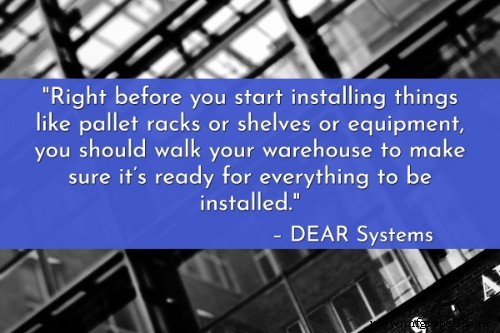
7. Pruebe su diseño de diseño antes de comenzar a instalar estantes y estantes nuevos. “Justo antes de comenzar a instalar elementos como estantes para tarimas, estantes o equipos, debe recorrer el almacén para asegurarse de que esté listo para instalarlo todo.
“Use cinta adhesiva para delinear las principales áreas de trabajo y transportar las cosas a través de ellas, Mueva transpaletas y haga que otros empleados simulen el trabajo al mismo tiempo.
“Esto le dará una comprensión visual de su espacio y si está optimizado o no. Cualquier error aquí resultará en errores peores más adelante”. – 4 consejos sobre cómo planificar de forma eficaz el diseño de un almacén , DEAR Sistemas; Twitter:@DearInventory
“Si no puede conseguir un plano, es fácil dibujar su propio esquema de almacén en papel cuadriculado. Generalmente uso un cuadrado =un pie cuadrado en mi esquema.
“Una vez que tenga un esquema impreso o en línea con medidas dibujadas a escala, anote cualquier característica estacionaria, como columnas o soportes, áreas de oficinas construidas, equipos instalados , puertas basculantes, etc., que tendrá que sortear.
“En mi almacén, la construcción de la oficina quita una parte del medio que tengo que planear. Incluso noté que la puerta de la oficina se abre hacia el almacén para que no la bloqueemos accidentalmente. Además, como operación de envío, las ubicaciones de las puertas basculantes son clave para mis flujos de trabajo de envío y recepción, por lo que las anoto para esos usos.
“Una vez que tenga listo su esquema, con sus características principales anotadas, es hora de comenzar planificación de su espacio.” – Krista Fabregas, Planificación del diseño de su almacén:cómo configurar áreas eficientes de almacenamiento, empaque y envío , FitSmallBusiness.com; Twitter:@FitSmallBiz
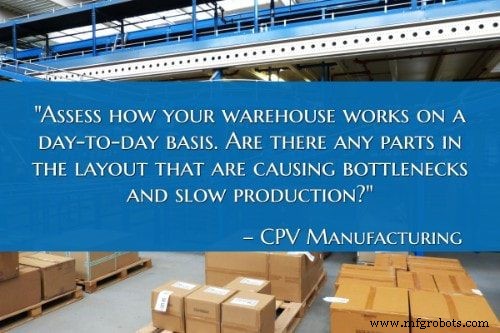
9. Cree un mapa de procesos. “Evalúa cómo funciona tu almacén en el día a día. ¿Hay alguna parte en el diseño que esté causando cuellos de botella y una producción lenta? Si es así, debe optimizar el diseño de su almacén para garantizar flujos de trabajo fluidos y eficientes.
“Haga un mapa de procesos que detalle cómo funcionan actualmente sus instalaciones y dónde se encuentra cada zona. Luego seleccione las áreas que deben cambiarse.
“Luego, cree un nuevo mapa de proceso con los cambios de diseño realizados. Por ejemplo, si notó un cuello de botella en la producción y el empaque, el nuevo mapa de procesos puede mover la zona de empaque para que pueda satisfacer fácilmente las demandas de producción”. – Cómo diseñar un almacén rentable:optimizar el diseño del diseño de su almacén , Fabricación de CPV; Twitter:@cpvmfg
“Primero, el tamaño del artículo será importante porque cuanto más espacio ocupen estos artículos, menos espacio tendrá para otras piezas de inventario, ya sea el mismo artículo o de lo contrario. Esto es importante porque, cuando administra un almacén, cada pie cuadrado le cuesta dinero. Además, examinar qué equipo de manejo de materiales se necesita para mover cada uno tendrá un impacto en el ancho de los carriles de tráfico necesarios entre el almacenamiento de inventario. Obviamente, los artículos que requieren montacargas u otra maquinaria pesada requerirán un carril más ancho. Sin embargo, también debe tener en cuenta el tráfico peatonal general en el área para garantizar la seguridad general de los empleados en sus instalaciones”. – Guía de planificación de almacenes:uso del espacio , Panel Construido, Incorporado; Twitter:@PanelBuilt
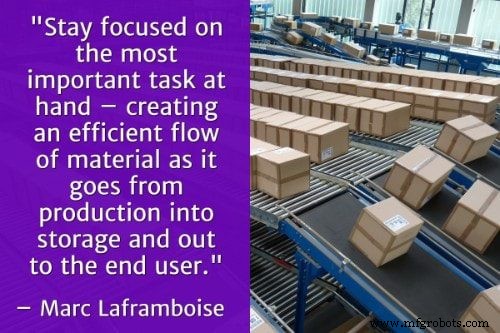
11. No se limite a diseñar un diseño de almacén por ahora. También debe crear diseños adicionales que se adapten al crecimiento futuro proyectado. “Mi experiencia en lo que respecta a la creación de diseños de diseño de almacenes varía desde espacios existentes superpoblados hasta edificios completamente vacíos que buscan alguna dirección. Mi recomendación inicial para ambos es poner sus ideas y conceptos en papel.
“Claro, se ve muy bien tener un Diseño 3D de AutoCAD realmente nítido del diseño de su almacén, pero es importante comenzar con lo básico y poner un lápiz a papel. Manténgase enfocado en la tarea más importante que tiene entre manos:crear un flujo de material eficiente a medida que pasa de la producción al almacenamiento y al usuario final.
“El flujo de material eficiente se puede lograr de inmediato con el equipo, los medios de almacenamiento y las Amplio espacio, pero todo depende de qué tan bien esté diseñado para soportar su rápido crecimiento. Trate de pronosticar el crecimiento futuro y cree un diseño para ahora, así como algunos otros diseños para el futuro”. – Marc Laframboise, Diseños de distribución de almacenes , El Manipulador De Materiales; Twitter:@MaterialH4ndler
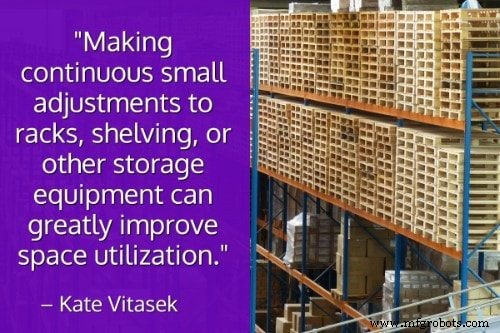
13. Revise regularmente el diseño y los procesos de su almacén para identificar ineficiencias. “La mayoría de las empresas ponen mucho esfuerzo en el diseño inicial del almacén; sin embargo, las encuestas de la industria le dirán que hasta la mitad de las empresas no cuentan con un proceso continuo para revisar sus diseños. Revisar cómo se configuran las áreas de almacenamiento y contar con procesos para reconfigurar las áreas de almacenamiento a medida que cambia la combinación de productos se considera una buena práctica y es fundamental para mantener altos niveles de eficiencia y utilización del espacio. Hacer pequeños ajustes continuos en los bastidores, estanterías u otros equipos de almacenamiento puede mejorar en gran medida la utilización del espacio.
“Todo el software de almacenamiento se ejecuta en datos, por lo tanto, los datos de ubicación de almacenamiento y productos deben mantenerse actualizados y precisos. Best-practice companies maintain all information on a single system of record and keep it current and accurate. Product data should include all product characteristics including cube data, lot/serial-number information, and special requirements so that product can be directed to special storage areas. Special storage areas may be used to segregate items with odor transfer or fire risk or that require temperature control. High-value product might require caged or controlled-access storage.” – Kate Vitasek, Storage and Inventory Control Best Practices , Multi-Channel Merchant; Twitter:@mcmerchant
14. If you’re redesigning an existing warehouse layout, determine what changes must be made immediately and what changes will require more time to implement. “Once you have decided to initiate changes, identify what changes should be initiated immediately and completed within three to six months and which changes require longer to implement and complete. It’s equally important to determine which action items are capital-intensive. These may be either necessary or secondary but will be required in the long term.” – Warehouse Assessment to Identify Ways to Increase Facility Capacity , F. Curtis Barry &Company; Twitter:@FCurtisBarryCo
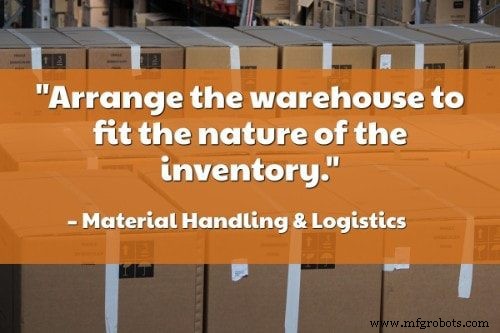
15. A simple spreadsheet analysis can provide insight into how many rows of various depths and how many racks are needed. “Arrange the warehouse to fit the nature of the inventory. If it will store large quantities of few SKUs, many deep rows are needed. If the inventory will be small quantities of many SKUs, mostly shallow rows with many faces is more practical.
“A simple spreadsheet analysis calculates how many rows of varying depths and how many racks are needed. From this it calculates the area needed for storage and aisles. Space for docks, offices and future expansion are not included.
“The analysis is based on a ‘snapshot’ of current inventories, modified to include future changes. Although individual SKUs may vary from week to week, the mix of deep and shallow rows is surprisingly stable and one period can be very representative. The height pallets can be stacked depends on the weight of the product, strength of the packaging, building height, etc.” – Planning a Warehouse , Material Handling &Logistics
“One of the main components in layout design is optimizing the ability to accommodate various types of pallet loads. Some warehouses handle single pallets with one SKU, which is easy to receive and easy to store. Other warehouses, however, handle loads of chemical materials and other substances, which need to be quarantined and tested before storing. Whether you’re handling pallet loads with one SKU or 1000, we design a receiving area that can support operations. We make sure you have ample dock and receiving space.” – Layout Design , Warehouse1; Twitter:@warehouse1
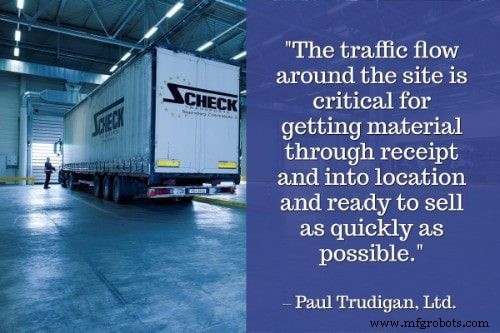
17. Perform a slotting analysis. “Now that you have separated your inventory by product category, velocity, and unit of measure, the next stage is to perform a slotting analysis to balance your inventory. Slotting is the process where you define the quantity and size of all your forward pick and reserve locations. This is determined by analyzing the best combination of product category, velocity, and unit of measure to place in forward pick locations, and where to store the reserve inventory for each product category by velocity. It is important to have dimensions and cubic volume for every product in each unit of measure you inventory. Balancing inventory with picking and replenishment is critical when determining the size of your pick faces. To decide how large your pick faces should be, analyze the cube, velocity, and the number of times you want to replenish each product group and velocity combination.” – Victor Coronado, Optimizing the Warehouse to Maximize Space and Efficacy , LinkedIn
- Throughput efficiency
- Building utilization
- Safety
- Environmental aspects
“After drawing the possible layouts, they should be validated. This validation should be made according an operational and a technical feasibility point of view, checking that the layouts meets the requirements proposed in the first step of the framework. Finally, the preferred layout should be chosen. For that, all the possible layouts are going to be put together and different conclusions are going to be drawn, both quantitative (e.g., financial costs) and qualitative (e.g., SWOT analysis). After all this it is possible to choose the design that best meet the company activity and expectative.” – Beatriz del Río Tomé, Material flow design in a warehouse: The case of S:t Eriks , Lund University; Twitter:@lunduniversity

19. Not enough data? Conduct a survey. “In some cases, there simply is not enough good quality data to create a reliable design. When this happens, it’s time to roll up the sleeves and survey the distribution center, collecting visual information on what needs to be stored. There are generally four methods which can be used to gather this information:
- Method #1:Product cube:Use a database of product dimensions.
- Method #2:Survey storage cube:Survey each item in each bin in the distribution center. Record the SKU number and capture some information as to the amount of space occupied by that SKU in the distribution center.
- Method #3:Utilize bin cube (bin-by-bin):Measure the dimensions of each bin, and capture the rough percentage of space in each bin which is occupied by product. This is not a SKU-specific method.
- Method #4:Utilize bin cube (aggregate):Measure the dimensions of each bin, and determine a general utilization factor that applies to each bin type. This is not a SKU-specific method.” – John Diebold, Planning a Warehouse Layout with Imperfect Data , Commonwealth Supply Chain Advisors
Considerations When Designing a Warehouse Layout

21. Traffic flow is a key consideration in any warehouse layout design. “This may sound like an obvious focus for warehouse design, but it is regularly overlooked, or compromised in favor of maximizing a building’s square footage. The traffic flow around the site is critical for getting material through receipt and into location and ready to sell as quickly as possible. Go to any industrial estate in the UK and you will see trucks parked up on the public highway waiting to be able to access sites for unloading. This waiting time costs businesses money in both demurrage and the potential for delayed orders and lost sales. You must ensure that the exterior layout and traffic flow is sufficient to receive, offload and despatch goods in the quickest turnaround times possible.
“Efficient traffic flow starts with incorporating the right number of bays into the warehouse layout and the right configuration of bays. Depending on the type of operation, there should be a mix of level access bays and dock level bays. For example, in an e-commerce operation material may come in on curtain sided trailers that need to be unloaded from the side and enter the warehouse through a level access bay. However, for despatch, orders may be despatched onto rigid vehicles requiring rear-loading and consequently dock level bays.” – Warehouse Design – 5 Tips for Success , Paul Trudigan, Ltd.; Twitter:@paul_trudigan
“In our previous blog post about warehouse safety we discussed how by designing your warehouse to minimize the amount your staff have to bend, reach and twist can help them work better, without the risk of injury. Ensuring that your inventory does not need to be moved more than once can also help.” – 4 ways to improve your warehouse layout design , Kerridge; Twitter:@KerridgeCS
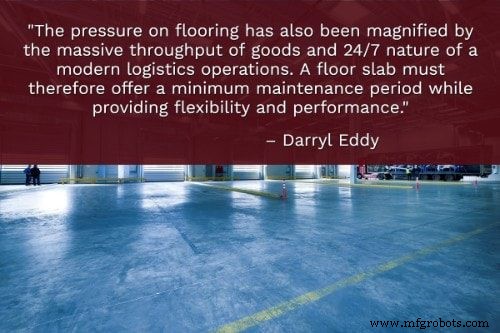
23. Flooring is actually a consideration that can have substantial impacts on a warehouse operation. “The emphasis on warehouse flooring has undeniably increased due to modern building techniques. The quality and durability of a floor slab can affect, for good or bad, all elements of the process in a warehouse. ‘With many warehouse and logistics operators now taking full advantage of new technology that often requires bigger and taller buildings, the demand for a flatter floor is significantly higher,’ exemplifies Darryl Eddy, director of Twintec Industrial Flooring.
“The pressure on flooring has also been magnified by the massive throughput of goods and 24/7 nature of a modern logistics operations. A floor slab must therefore offer a minimum maintenance period while providing flexibility and performance.
“‘Traditional ground-bearing floor slab construction uses concrete nominally reinforced with fairly light mesh and then incorporates saw-cuts to induce shrinkage cracks to a pre-planned grid,’ says Eddy. ‘Floors with such joints are prone to curl, and are very bumpy for forklifts, eventually leading to breakdown and ongoing maintenance for both floor and machines.’
“In order to design and build a floor for a warehouse, it is necessary to understand the properties of the floor constituent materials. By examining concrete mix, fibre type and fibre dosage, a warehouse operator can evaluate which floor will best match the demands of the warehouse in question. ‘Steel Fibre Reinforced Concrete (SFRC) is a composite material and can be used to produce reinforced floors that do not require joints, therefore reducing maintenance of forklift and floor,’ says Eddy.” – Darryl Eddy, as quoted by Middle East Logistics Staff, Top 10 tips for warehouse design , Middle East Logistics; Twitter:@Logistics_ME
“Contrary to what some may think, your warehouse layout should actually be very flexible. That way, it can easily accommodate your business as it changes over time—from expanding product to storing new, different-sized items.
“That being said, take a look at your design—or hire a professional to analyze it for you. Your aisles may be too wide or you could be basing the design around your rack system or lift equipment instead of the building.
“After thoroughly assessing your layout (and going over your options like installing a mezzanine or modular inplant office, etc.) can you decide whether non-productive aisles really are the problem or perhaps you really have run out of space and need to upgrade to a larger facility.” – 9 Warehouse Solutions to Maximize Non-Productive Aisles Without Breaking the Bank , Specialized Storage Solutions
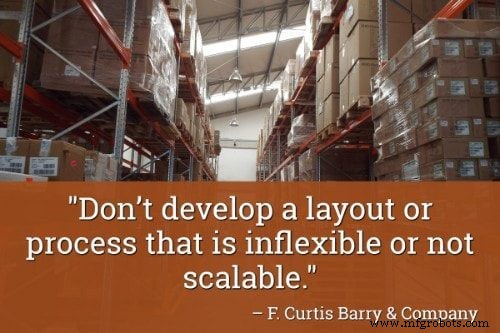
25. Your warehouse layout design should be both flexible and scalable. “Planning for unknown future changes to the business or fulfillment model is a necessity to avoid unnecessary costs to make unplanned changes to the facility and operation. Don’t develop a layout or process that is inflexible or not scalable. Read about how to develop an effective warehouse layout process here.” – Warehouse Layout Design Principles , F. Curtis Barry &Company; Twitter:@FCurtisBarryCo
- Low activity/low storage requirements – Often seen in smaller operations where manual handling is the norm.
- High activity/low storage requirements – Characterized by a single forward picking area with minimal storage overflow.
- Low activity/high storage requirements – Frequently a manual or semi-manual picking procedure that necessitates multi-level, high-density storage.
- High activity/high storage requirements – Typical of large-scale distribution centers, these fast-paced facilities rely heavily on automated material handling systems and extensive storage capacity.
“Heating, cooling, and humidity controls can also have significant bearing on the warehouse design. Some require more general accouterments like storage, sufficient aisle space, designated receiving and shipping areas, etc. Others must protect perishables with proper chill space, refrigeration requirements and humidity control equipment.” – A Guide to Getting the Most out of a Warehouse Design Service , Rack Express; Twitter:@rackexpress
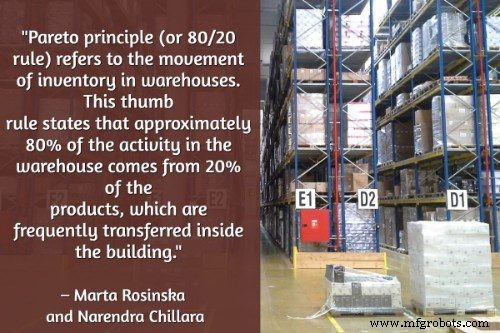
27. The Pareto Principle is applicable to the movement of inventory in warehouses. “Different warehouses use various storage methods and different types of racks or mezzanines. The combination of different types of storage systems is extremely important in maximizing the usable space. The storage equipment storage be selected based on the movement of livestock (Ten Hompel et al., 2007).
“Pareto principle (or 80/20 rule) refers to the movement of inventory in warehouses. This thumb rule states that approximately 80% of the activity in the warehouse comes from 20% of the products, which are frequently transferred inside the building. Next 15% of the activity is derived from the 30%stock keeping units (SKUs), which mobility rate is defined as the average. Finally, 5% of the activity comes from 50% of the inventory, which are stored in a slow manner. By separating the fast, medium and slow-moving products within the plant and increasing access to products requiring the highest activity, the throughput can be increased significantly.
“Moreover, by facilitating access to these products, additional time can be gained to transfer the products inside the building (Ackerman, 2013).
“Parts with high turnover are usually stored in warehouses with high volumes using pallet racking with standard width passes. Companies that have a reach truck can store products with a high turnover in places where there are narrow aisles. Products with an average circulation are more suitable for storage in narrow aisles. Lastly, it is suggested to store slow-moving products in a very narrow aisle by trucks with rising cabin. However, this is only theory that aim to support the decision how to store goods. Depending on the situation and needs, the scenario might be different (Ten Hompel et al., 2007).” – Marta Rosinska and Narendra Chillara, Layout design planning of a logistics center: A study on space utilization after merger of two warehouses , Department of Technology Management and Economics, Division of Supply and Operations Management, Chalmers University of Technology; Twitter:@chalmersnyheter
“At the other end of the spectrum, chemical or pharmaceutical materials may require lab testing before they can be accepted for putaway into inventory. This means product must be quarantined in a separate receiving area while it awaits testing.” – Lisa Harrington, Designing the Perfect Warehouse , Inbound Logistics; Twitter:@ILMagazine
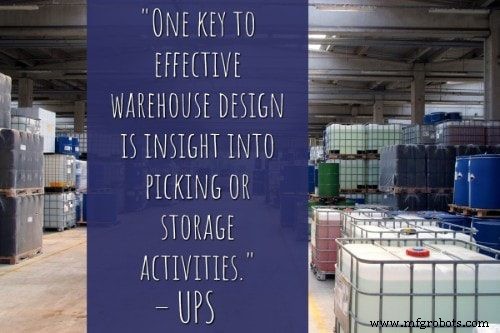
29. Don’t over-complicate picking processes by overemphasizing storage needs. Instead, your goal is to find the perfect balance between the two. “Because warehouses are a buffer for inbound shipments from suppliers and outbound orders to customers, the nature of warehousing often changes from storage to transaction. In addition, overseas sourcing increases the need for warehousing–increasing its importance in the supply chain.
“One key to effective warehouse design is insight into picking or storage activities. A large warehouse space can meet storage needs but complicate picking processes. You need to find a balance for the design of your warehouse.” – Warehouse Design and Layout , UPS; Twitter:@UPS
30. Allow ample space for goods-in. “The goods receiving area of your warehouse is generally a hive of activity, which all too often is crammed into an inadequate space for the purpose.
“While it may seem counterintuitive to give up floor and racking space to expand the goods-in section of your warehouse, releasing a larger floor area here can often lead to greater overall warehouse layout efficiency—and therefore reduced operating costs.” – Rob O’Byrne, 4 Ways to Improve Warehouse Layout Efficiency and Save Costs , Logistics Bureau; Twitter:@LogisticsBureau
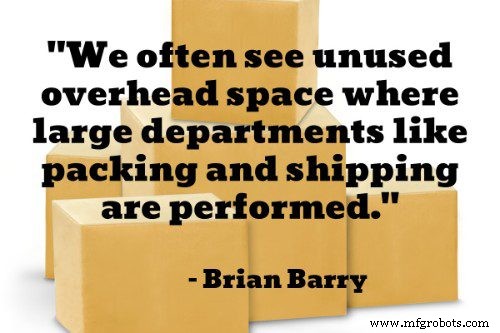
31. Analyze department space to tap into unused overhead space. “Identify functions that do not require high ceilings in areas where lower stacking heights are dictated by the clear height. We often see unused overhead space where large departments like packing and shipping are performed.
“Look up and make sure you’re using all the vertical space available. Investigate storage media to take advantage of your clear span height. How much cubic feet of vertical space is not being used? Be sure to know how your design might impact your sprinkler design and fire code.” – Brian Barry, 15 Ways to Improve Warehouse Space Utilization , Multi-Channel Merchant; Twitter:@mcmerchant
32. Give forklift operators as wide a path as possible. “Space is also key in maintaining an efficient environment for forklift operation. That doesn’t simply refer to the square footage of the warehouse. It’s possible to have a very large facility with little operable space. The idea here is to provide as a wide of a path as possible for your forklift operators. One easy way to do this is to keep all stored products and packages up against a wall. If your inventory and/or space limitations require the construction of aisles, then make sure you have plenty of space between rows for a forklifts to maneuver without being cramped. The width between aisles will largely depend on the type of forklifts you are using as models vary in terms of turning radius, elevation and reach. Once you’ve identified the forklift models in your warehouse, construct your aisles accordingly. This will not only speed up work flow, it will also go a long way in avoiding accidents..
“Width between aisles isn’t the only important consideration in the layout of your aisles. Logical and proper labeling is also key. As much as possible, try to stack items of a similar kind or category in the same aisle, and make sure each aisle is clearly labeled so employees know which items can be found there. This will avoid hours of confusion and backtracking that can result when employees are not sure where to find specific inventory items. Creating short cuts through aisles can also help to streamline storing and delivery. Putting gaps in the middle of aisles will allow employees to make a direct a path to the items they need without having to walk or drive forklifts around entire aisles to get there.” – Tom Reddon, Best Practices for an Efficient Warehouse Layout , National Forklift Exchange; Twitter:@TomReddon
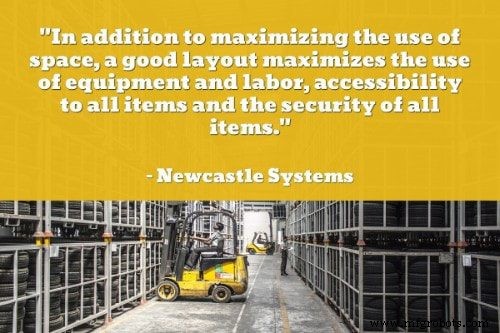
33. An optimized warehouse layout not only maximizes the use of horizontal and vertical space, but also equipment and labor. “The optimal layout factors both the floor space and the vertical space available for use. In addition to maximizing the use of space, a good layout maximizes the use of equipment and labor, accessibility to all items and the security of all items. Using forklifts that reach the roof of the warehouse allows for a configuration that maximizes both the horizontal and vertical space.
“The complementary solution is to ensure that the highest-selling inventory is easily accessible by placing it at the most accessible point.” – Top Five Warehouse Management Problems and How to Fix Them , Newcastle Systems; Twitter:@NewcastleSys
34. Review global layout efficiency. “It’s always been like this and to complicate to change. This is the common comments. Start looking at the global warehouse configuration and think of those 3 basic points:space utilization, productivity and global operation control &management. Look at opportunity to change considering those points:aisle orientation, product flow, incoming and outgoing operation, location of services area (employee access, building services, working area (repack etc)), fix equipment location (stretch wrap, scale, packing tables, etc). Look at measuring productivity per sector or operation and evaluate time consumption and finally review your WMS performance.” – Albert Goodhue, Warehouse Layout Optimization:Some basics steps , GCL Logistics &Supply Chain Consulting
Warehouse Layout Design Ideas
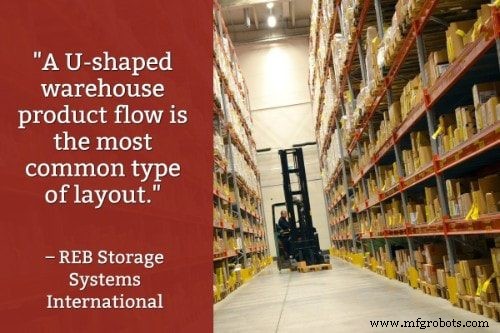
35. A U-shaped product flow is the most common type of warehouse layout, but that doesn’t mean it’s the best layout for your business. “A U-shaped warehouse product flow is the most common type of layout. In this layout the shipping and receiving docks are located next to one another, offering shared utilization of dock resources such as personnel and material handling equipment. This layout also minimizes product handling, offering high cross-docking capability.” – Warehouse Layout &Product Flow Options , REB Storage Systems International; Twitter:@REB_Storage
36. If you need enhanced security, an I-shaped or L-shaped warehouse layout may be better suited to your needs. “I-shaped warehouse product flow and L-shaped warehouse product flow, also known as through flow, are similar in that the shipping and receiving areas are located on different sides of the warehouse. As a result, these require more available warehouse space than U-shaped layouts.
“These layouts can be beneficial for certain operations. For example, warehouses that require heightened security can benefit from the separate ‘in’ and ‘out’ areas. I-shaped and L-shaped layouts can also provide larger sorting and storage areas for both shipping and receiving docks as well as allowing for isolated monitoring of each function.” – Warehouse Layout &Product Flow Options , REB Storage Systems International; Twitter:@REB_Storage
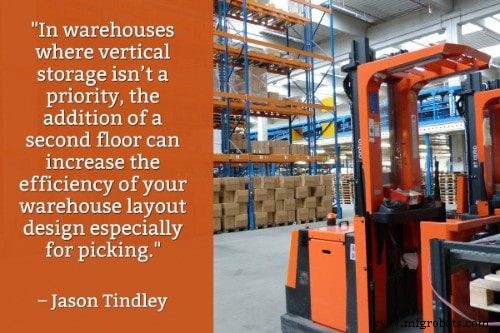
37. Consider adding a floor. “In warehouses where vertical storage isn’t a priority, the addition of a second floor can increase the efficiency of your warehouse layout design especially for picking. Mezzanine floors offer a way to maximize warehouse space without the high costs of complete renovation. These types of floors are ideal for small warehouses looking to expand their space due to increased product demand.” – Jason Tindley, How To Design An Efficient Warehouse Layout In 10 Easy Steps , Logistics Planning Consultants; Twitter:@LPCINT
38. Incorporate cross aisles. “If all of the aisles in your warehouse are long and continuous, it could make getting from one place to another extremely difficult. Increase efficiency by creating a grid of cross aisles.” – 6 Smart Tips on How to Improve Your Warehouse Layout Design , Porta Power, Inc.; Twitter:@PortaPowerInc
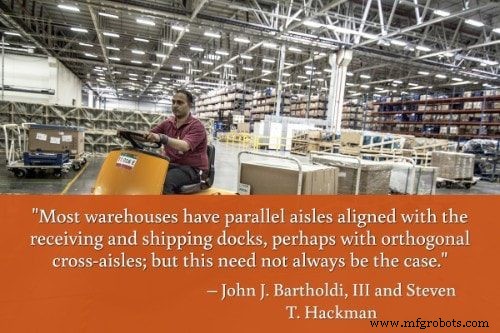
39. A fishbone layout, featuring angled aisles, is touted by some experts. “Most warehouses have parallel aisles aligned with the receiving and shipping docks, perhaps with orthogonal cross-aisles; but this need not always be the case. Kevin Gue of Auburn University and Russ Meller of the University of Arkansas [23] have argued that travel times can be reduced by up to 20% by reorienting some aisles and including some angled cross-aisles, which they call a fishbone layout. The overall warehouse must be slightly larger to compensate for the space lost to the additional aisles; but this is more than made up for by the efficiency of more direct travel to or from a centralized point of receiving and shipping.
“It is possible to take advantage of this more direct travel if most pallet movement is to or from the central dispatch point. But if a forklift finishes putting away a pallet and then must retrieve another, the orientation of the aisles of the fishbone arrangement may not help at all, and indeed may be an impediment. Nevertheless, this possibly inefficiency seems to be more than made up for by the direct travel to and from the central dispatch point.” – John J. Bartholdi, III and Steven T. Hackman, Warehouse &Distribution Science , Release 0.94, The Supply Chain and Logistics Institute, School of Industrial and Systems Engineering, Georgia Institute of Technology (Latest version, Release 0.98, can be downloaded from Warehouse-Science.com)
40. Ensure that processes are positioned closely to other processes and functions they rely on. “The overall layout of the warehouse is an important factor in the optimization of operations. The flow throughout should generally move in either a line or a ‘U’ shape. In this facility there is a single door for both incoming shipments and outgoing orders, so the flow should be in a circular manner. Beginning with reception from the manufacturer, to putaway and replenishment, to order picking and fulfillment, and finally concluding with packaging and delivery to the outgoing shipper, each process should be in close proximity to those it relies upon.” – Tobiah R. Master, Warehouse Redesign of a Facility Layout, Racking System, and Item Classification at Sunrize Tackle, Inc. , California Polytechnic State University; Twitter:@CalPoly
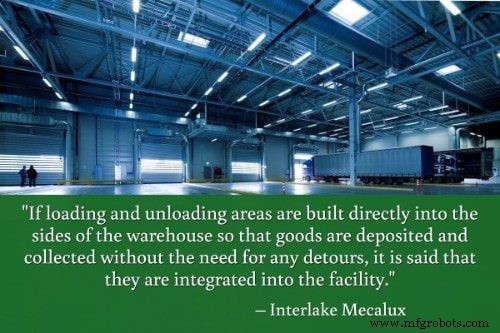
41. If space is available, integrated loading and unloading areas can offer greater load handling speed. “If loading and unloading areas are built directly into the sides of the warehouse so that goods are deposited and collected without the need for any detours, it is said that they are integrated into the facility. The main advantage of this is the greater load handling speed, which means it is preferable to non-integrated options if there is sufficient space for it.
“Trucks are connected to the warehouse via the docks and these docks can be:
- Docks separated by an intermediate platform: They are appropriate when this separation is advisable as determined by the nature of the goods or the need to maintain the internal warehouse environment or when there are safety issues relating to the material stored. A typical example of applying this type of separated dock is for cold chambers, where cold loss could occur if a flush dock is used with an access door and where this must be avoided at all costs. Yet there are many other circumstances in which this design is preferable, particularly when the safety of the warehouse could be compromised.
- Flush docks: They allow trucks to back right up to the warehouse wall. To avoid affecting the internal environment of the facility, access doors must have, as a minimum, a hermetically sealed system. This seal can be metal or created through the use of a dock shelter.” – Warehouse layout design , Interlake Mecalux; Twitter:@IKMXus
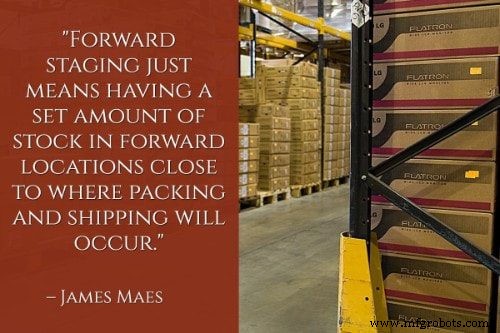
43. Incorporate forward locations to streamline picking efficiency. “Another way to optimize picking is by using forward locations. Forward locations can be a huge time saver, especially with more popular or high-volume items. The idea is to minimize trips to more remote locations in the warehouse at the same time that you minimize the distance a picker has to travel to get an item.
“Forward staging just means having a set amount of stock in forward locations close to where packing and shipping will occur. When an order for one of these items comes in, an employee can choose items from the forward location quickly. As the quantities in the forward location get low, replenishment stock from elsewhere in the warehouse (or from a less expensive off-site location) can then be brought forward.” – James Maes, 8 Tragically Common Mistakes in Warehouse Setup , Infoplus Commerce; Twitter:@infopluscommerc
44. Rethink your rack and shelving solution, and expand vertically. “Rather than expand the footprint of your warehouse, consider better use of vertical space. Adding taller storage units and the right equipment to pick and store material can help you keep more in the same square footage, rather than adding expansion costs. In addition, think about the type and variety of shelving used. Storing small items on pallet racks wastes space, and makes it easy to misplace items. Rather than using the same racks throughout your warehouse, you may need various types of shelving for different materials. Also, try using standardized bins to help keep shelves neat and orderly.” – Danny Hammack, Five simple ways to improve warehouse efficiency , CIPS; Twitter:@supplymgmt
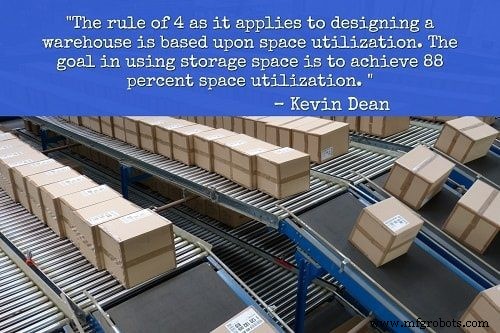
46. Other experts suggest that operations run best at about 85% full. A facility under 85% full reduces potential profit. “Inventory is a huge factor in determining an optimized layout for your warehouse. The type of inventory you distribute, the amount, and the length of time the product is in the warehouse are all things that should be taken into consideration during the planning process. Things like the inbound and outbound process as well as the way the items are stored should also be considered. Aside from the type of inventory, you should also consider how much you are going to keep available at your warehouse at any time. Operations run best at about 85% full, anything more than that will be less efficient and anything less would reduce your potential profit. Projected order statistics along with past data can help determine an optimized solution.” – Optimize Your Warehouse Layout , Supply Chain Link; Twitter:@NFIindustries
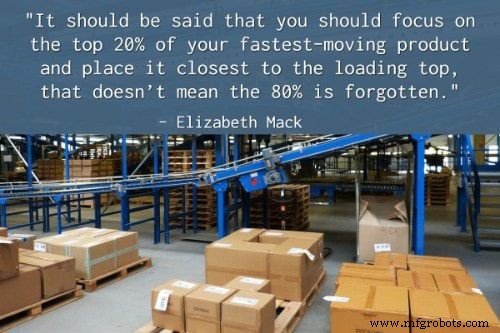
47. Use high-density shelving to organize slow-moving inventory. “It should be said that you should focus on the top 20% of your fastest-moving product and place it closest to the loading top, that doesn’t mean the 80% is forgotten. This is where high-density shelving systems come into play.
“In particular, high-density shelving systems are great for storing slow-moving product. Often times, businesses are so focused on their fast-moving product that slower-moving product is put on the wayside.
“What this type of shelving system does is double your storage capacity and make it easy and efficient for employees to retrieve inventory. Its accessibility and space-saving features are the reasons why we added it to the list.” – Elizabeth Mack, Warehouse Solutions You May Need to Make Your Facility More Efficient , Specialized Storage Solutions
48. Incorporate the four functional warehouse zones in your layout. “The top 4 functional warehouse zones identified using forecasting and projections are storage, yard/dock, picking and VAS/kitting zones. To identify the proper size of the storage area evaluate key factors such as project inventory levels, temperature requirements, product dimensions, fulfillment rules, flow through rates and more. All of these factors will play a part in determining proper storage layout. Data must also be collected to determine yard and dock door requirements. Too little staging space and dock doors can create a significant bottleneck, slowing down warehouse productivity. When determining picking and shipping size and location identifying your picking strategy will help to make these decisions. Consider the space requirements needed for all types and which will work best for your available resources.” – Cold Storage Warehouse Best Practices:Warehouse Layout Optimization , Datex; Twitter:@Datexcorp
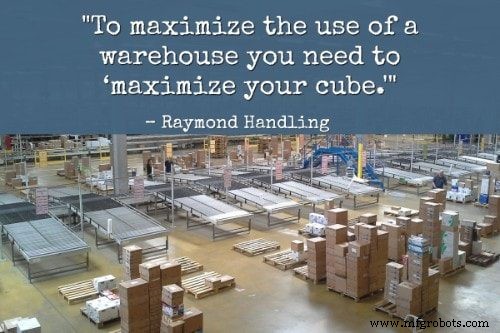
49. Maximize your cube. “To maximize the use of a warehouse you need to ‘maximize your cube.’ You need to take advantage of all of the vertical space that you have available. With a conventional fire protection system you can stack products up to 18” below the fire sprinkler heads. In an ESFR (Early Suppression, Fast Response) system this distance is 36”. You may need to reconfigure your existing storage system to take advantage of this space but it could be worth the effort.” –
How to optimize your existing warehouse space , Raymond Handling; Twitter:@RaymondHandling
50. Keep special processing areas under control. “Create space-saving layouts for special processing areas such VAS and returns. According to Elenbark [Bill Elenbark, senior engineer for the supply chain consulting firm TranSystems], special processing areas have a tendency to creep in size and spread out over larger areas than are required. It may be high time to take a closer look and consider making space-saving changes. If a lot of pallets are sitting on the floor, consider adding a short section of pallet rack to take advantage of cube. Carousels can be used as buffers to accumulate processed returns before returning them to inventory.” – Maida Napolitano, Space Optimization:Mission Impossible? , Logistics Management; Twitter:@LogisticsMgmt
Products and Tracking Solutions from Camcode:
- Rack Location Labels
- Barcode Stickers
- Barcode Warehouse Labels
- UID Labeling
- Inventory Labels
- Aisle Signs
- Equipment ID Tags
- Custom Warehouse Signs
- Etiquetas de aluminio
Tecnología Industrial
- Diseño de productos médicos:consejos y trucos
- Planificación y diseño del sistema de distribución
- Diseño de chapa:consejos y trucos
- Software de diseño de PCB
- Consideraciones de diseño de PCB
- 5 consejos de diseño para RIM
- Consejos de diseño para moldeo por fundición
- Servicios de diseño de Protocase:6 consejos
- 4 consejos sobre el diseño de estanterías de almacén
- Consejos y consideraciones:aprenda a mejorar sus habilidades de diseño de PCB
- Sugerencias de diseño de alta velocidad



